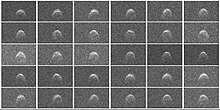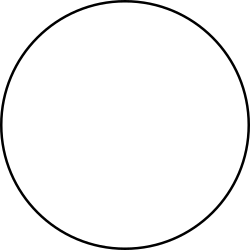List of asteroid close approaches to Earth in 2013
From Wikipedia, the free encyclopedia
| Time of discovery of asteroids which came closer to Earth than the Moon in 2013 |
|
Below is the list of asteroid close approaches to Earth in 2013. This was the year of the Chelyabinsk impact, in addition to the other NEO flybys
Timeline of known close approaches less than one lunar distance from Earth in 2013[edit]
A list of known Near-Earth asteroid close approaches less than 1 lunar distance (384,400 km or 0.00256 AU) from Earth in 2013.[note 1]
Rows highlighted red indicate objects which were not discovered until after closest approach
Rows highlighted yellow indicate objects discovered less than 24 hours before closest approach
Rows highlighted green indicate objects discovered more than one week before closest approach
Rows highlighted turquoise indicate objects discovered more than 7 weeks before closest approach
Rows highlighted blue indicate objects discovered more than one year before closest approach (i.e.
objects successfully cataloged on a previous orbit, rather than being detected during final approach)
This list does not include any of the 24 objects that collided with earth in 2013, none of which were discovered in advance, but were recorded by sensors designed to detect detonation of nuclear devices. Of the 24 objects so detected, 5 had an impact energy greater than that of a 1 kiloton device including the 440 kiloton Chelyabinsk meteor, estimated at 20 m in diameter, which injured around 1500 people and damaged over 7000 buildings. [1][2][3]
| Date of closest approach |
Date discovered |
Object | Nominal geocentric distance (AU)[note 2] |
Nominal geocentric distance (LD) |
Size (m) (approximate) |
(H) (abs. mag) |
Closer approach to Moon |
Refs[4][5] |
|---|---|---|---|---|---|---|---|---|
| 2013-01-15 | 2013-01-20 | 2013 BR27 | 0.00145 AU (217,000 km; 135,000 mi) | 16 | 7-16 | 27.8[6] | Yes | data · 2013 BR27 |
| 2013-01-28 | 2013-02-01 | 2013 CY | 0.00230 AU (344,000 km; 214,000 mi) | 13 | 6-13 | 28.3[7] | data · 2013 CY | |
| 2013-02-05 | 2013-02-06 | 2013 CY32 | 0.00070 AU (105,000 km; 65,000 mi) | 14 | 6-14 | 28.1[8] | data · 2013 CY32 | |
| 2013-02-11 | 2013-02-14 | 2013 CL129 | 0.00185 AU (277,000 km; 172,000 mi) | 12 | 5-12 | 28.4[9] | Yes | data · 2013 CL129 |
| 2013-02-15 | 2012-02-23 | 367943 Duende | 0.0002276 AU (34,050 km; 21,160 mi) | 30 | 42-94 | 24.0[10] | data · 2012 DA14 | |
| 2013-03-04 | 2013-03-02 | 2013 EC | 0.00245 AU (367,000 km; 228,000 mi) | 16 | 7-16 | 27.8[11] | data · 2013 EC | |
| 2013-03-09 | 2013-03-07 | 2013 EC20 | 0.001003 AU (150,000 km; 93,200 mi) | 9 | 4-10 | 29.0[12] | data · 2013 EC20 | |
| 2013-04-18 | 2013-04-19 | 2013 HT25 | 0.00036 AU (54,000 km; 33,000 mi) | 10 | 4-10 | 28.8[13] | data · 2013 HT25 | |
| 2013-06-08 | 2013-06-06 | 2013 LR6 | 0.000742 AU (111,000 km; 69,000 mi) | 16 | 7-16 | 27.8[14] | data · 2013 LR6 | |
| 2013-08-04 | 2013-08-04 | 2013 PJ10 | 0.00248 AU (371,000 km; 231,000 mi) | 60 | 32-71 | 24.6[15] | data · 2013 PJ10 | |
| 2013-08-09 | 2013-08-07 | 2013 PS13 | 0.00136 AU (203,000 km; 126,000 mi) | 21 | 10-22 | 27.2[16] | data · 2013 PS13 | |
| 2013-09-03 | 2013-09-02 | 2013 RG | 0.00151 AU (226,000 km; 140,000 mi) | 7 | 3-8 | 29.4[17] | data · 2013 RG | |
| 2013-09-04 | 2013-09-05 | 2013 RO30 | 0.00194 AU (290,000 km; 180,000 mi) | 12 | 5-12 | 28.4[18] | data · 2013 RO30 | |
| 2013-09-05 | 2013-09-03 | 2013 RF32 | 0.00112 AU (168,000 km; 104,000 mi) | 10 | 5-11 | 28.7[19] | data · 2013 RF32 | |
| 2013-09-18 | 2013-09-13 | 2013 RZ53 | 0.00162 AU (242,000 km; 151,000 mi) | 3 | 2-4 | 31.1[20] | data · 2013 RZ53 | |
| 2013-10-04 | 2013-10-05 | 2013 TR12 | 0.00143 AU (214,000 km; 133,000 mi) | 11 | 5-12 | 28.5[21] | data · 2013 TR12 | |
| 2013-10-09 | 2013-10-10 | 2013 TL127 | 0.00251 AU (375,000 km; 233,000 mi) | 27 | 12-27 | 26.7[22] | Yes | data · 2013 TL127 |
| 2013-10-21 | 2013-10-23 | 2013 UR1 | 0.00168 AU (251,000 km; 156,000 mi) | 17 | 7-16 | 27.6[23] | Yes | data · 2013 UR1 |
| 2013-10-25 | 2013-10-24 | 2013 UX2 | 0.00100 AU (150,000 km; 93,000 mi) | 8 | 4-9 | 29.2[24] | data · 2013 UX2 | |
| 2013-10-29 | 2013-10-25 | 2013 UV3 | 0.00189 AU (283,000 km; 176,000 mi) | 25 | 12-26 | 26.8[25] | Yes | data · 2013 UV3 |
| 2013-11-08 | 2013-11-09 | 2013 VJ11 | 0.002283 AU (341,500 km; 212,200 mi) | 16 | 7-16 | 27.8[26] | Yes | data · 2013 VJ11 |
| 2013-11-29 | 2013-11-28 | 2013 WH25 | 0.0009 AU (130,000 km; 84,000 mi) | 7 | 3-7 | 29.6[27] | data · 2013 WH25 | |
| 2013-12-11 | 2013-12-12 | 2013 XS21 | 0.000484 AU (72,400 km; 45,000 mi) | 7 | 3-8 | 29.4[28] | data · 2013 XS21 | |
| 2013-12-23 | 2013-12-23 | 2013 YB | 0.00018 AU (27,000 km; 17,000 mi) | 3 | 1-3 | 31.4[29] | data · 2013 YB |
Warning Times by Size[edit]
This sub-section visualises the warning times of the close approaches listed in the above table, depending on the size of the asteroid. The sizes of the charts show the relative sizes of the asteroids to scale. For comparison, the approximate size of a person is also shown. This is based the absolute magnitude of each asteroid, an approximate measure of size based on brightness.
Abs Magnitude 30 and greater
(size of a person for comparison)
Abs Magnitude 29-30
Absolute Magnitude 28-29
Absolute Magnitude 27-28
Absolute Magnitude 26-27
(probable size of the Chelyabinsk meteor)
Absolute Magnitude less than 25 (largest)
- After closest approach: 1 (50.0%)
- < 24 hours before: 0 (0.0%)
- up to 7 days before: 0 (0.0%)
- > one week before: 0 (0.0%)
- > 7 weeks before: 1 (50.0%)
- > one year before: 0 (0.0%)
Notes[edit]
Additional examples[edit]


An example list of near-Earth asteroids that passed more than 1 lunar distance (384,400 km or 0.00256 AU) from Earth in 2013.
- 2013 XH22, December 18, 2013 (1.9 LD)
- 2013 XY8, December 11, 2013 (2 LD)
- 3361 Orpheus, December 7, 2013 (40.1 LD)
- 2001 AV43, November 18, 2013 (3 LD)
- (52760) 1998 ML14, August 24, 2013
- (277475) 2005 WK4, August 8, 2013[31]
- 2003 DZ15, July 30, 2013[32]
- 2006 BL8, July 26, 2013[32]
- 2009 FE, June 4, 2013[32]
- (285263) 1998 QE2, May 29, 2013
- (163364) 2002 OD20, May 23, 2013
- (7888) 1993 UC, March 20, 2013
- 2013 ET, March 9, 2013
See also[edit]
References[edit]
External links[edit]


Recent Comments